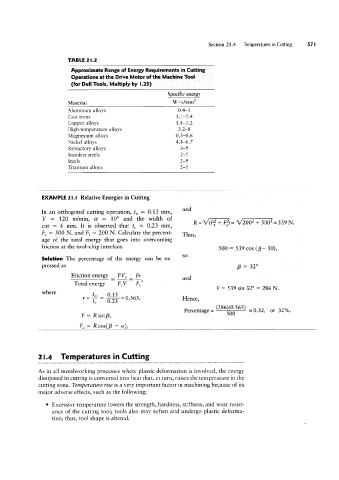Page 590 - 04. Subyek Engineering Materials - Manufacturing, Engineering and Technology SI 6th Edition - Serope Kalpakjian, Stephen Schmid (2009)
P. 590
Section 21.4 Temperatures in Cutting
TABLE 2 l.2
Approximate Range of Energy Requirements in Cutting
Operations at the Drive Motor of the Machine Tool
(for Dull Tools, Multiply by L25)
Specific energy
Material W S/mm3
°
Aluminum alloys 0.4-1
Cast irons 1.1-5.4
Copper alloys 1.4-3.2
High-temperature alloys 3.2-8
Magnesium alloys 0.3-0.6
Nickel alloys 4.8-6.7
Refractory alloys 3-9
Stainless steels 2-5
Steels 2-9
Titanium alloys 2-5
10° and the width of F
EXAMPLE 2|.l Relative Energies in Cutting
In an orthogonal cutting operation, to = 0.13 mm, and /1"
V = 120 m/min, 06 =
cut = 6 mm. It is observed that tc = 0.23 mm, R: (13% +F§)= 2002 + 5002=539N
PC = 500 N, and P, = 200 N. Calculate the percent- Thus
age of the total energy that goes into overcoming ’
friction at the tool-chip interface. 500 1. 539 COS B, 10)
(
Solution The percentage of the energy can be ex- so
pressed as B = 32°
Friction energy _ FV, __ Fr and
Total energy T FCV _ FC’
F = 539 sm 32° = 286 N
where to 013
V = Q; = = 0-565, Hence,
s___...__....r.,.r.. i>fl;...--...r..,...____..... ..,,,-,...-... .__.,. _ss
Percentage= =0.32, or
F : Rsing,
2|.4 Temperatures in Cutting
As in all metalworking processes where plastic deformation is involved, the energy
dissipated in cutting is converted into heat that, in turn, raises the temperature in the
cutting zone. Temperature rise is a very important factor in machining because of its
major adverse effects, such as the following:
° Excessive temperature lowers the strength, hardness, stiffness, and wear resist-
ance of the cutting tool; tools also may soften and undergo plastic deforma-
tion; thus, tool shape is altered.

